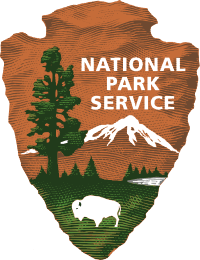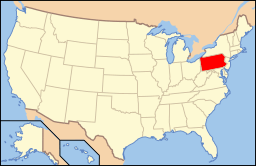Allegheny Portage Railroad
|
Allegheny Portage Railroad | |
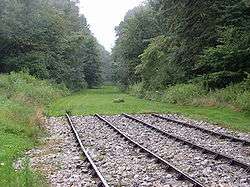 Incline 6 Trail and Recreated Tracks | |
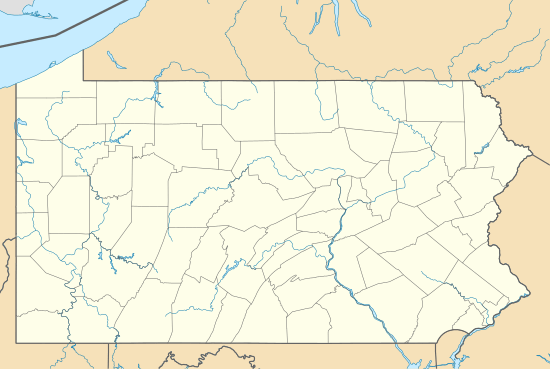 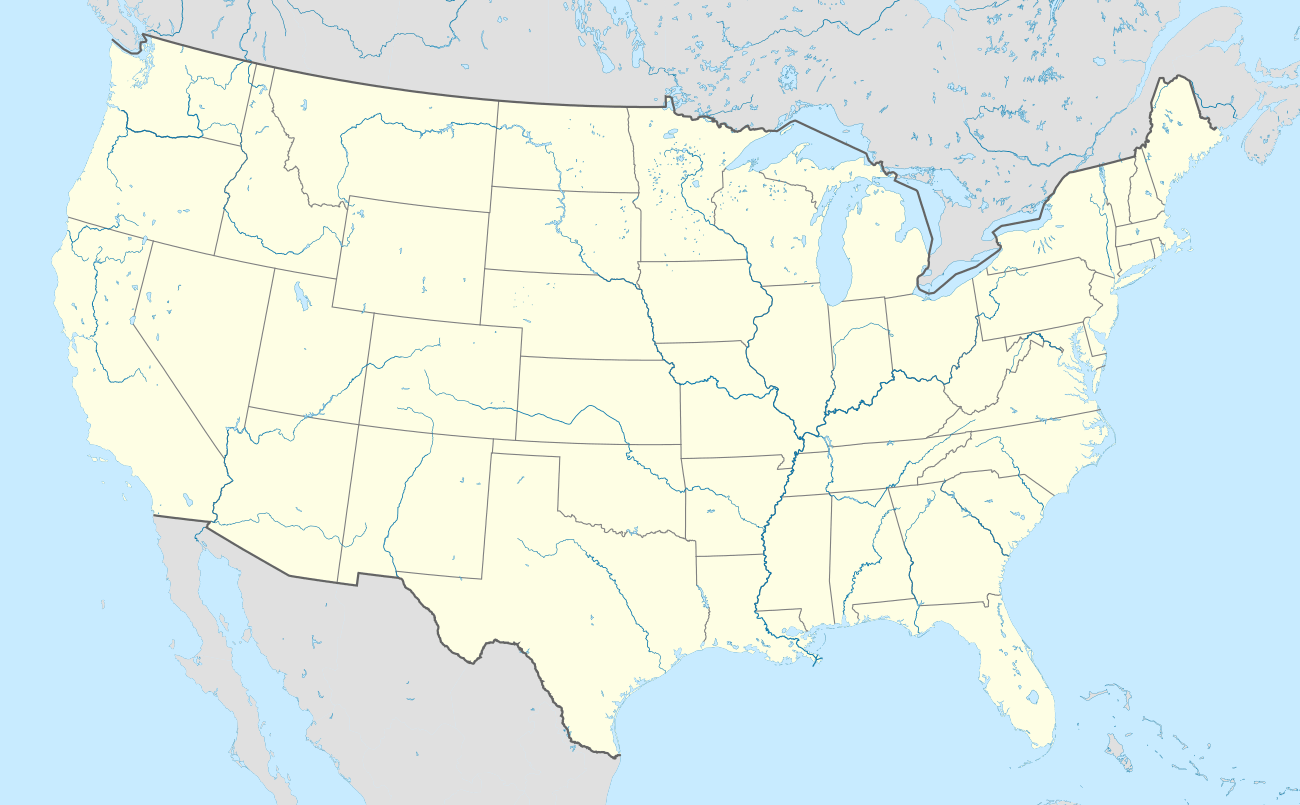 | |
| Location | Blair and Cambria counties, Pennsylvania, United States |
|---|---|
| Nearest city | Altoona, Pennsylvania |
| Coordinates | 40°27′15″N 78°32′25″W / 40.45417°N 78.54028°WCoordinates: 40°27′15″N 78°32′25″W / 40.45417°N 78.54028°W |
| Area | 1,296 acres (524 ha) |
| Built | 1831-1834 |
| Architectural style | Wood, Stone, Wrought Iron |
| Visitation | 118,931[1] (2009) |
| Website | Allegheny Portage Railroad National Historic Site |
| MPS | Allegheny Portage Railroad MPS |
| NRHP reference # | 66000648[2] |
| Significant dates | |
| Added to NRHP | October 15, 1966 |
| Designated NHL | December 29, 1962[3] |
| Designated PHMC | April 01, 1947[4] |
The Allegheny Portage Railroad was the first railroad constructed through the Allegheny Mountains in central Pennsylvania, United States; it operated from 1834 to 1854 as the first transportation infrastructure through the gaps of the Allegheny that connected the midwest to the eastern seaboard across the barrier range of the Allegheny Front. Authorized as part of the Main Line of Public Works legislation in 1824, it was a series of ten inclines connecting to a branch of the Pennsylvania Canal at either end, approximately 36 miles (58 km) long overall. It had five inclines on either side of the drainage divide running athwart the ridge line from Blair Gap through along the kinked saddle at the summit into Cresson, Pennsylvania. The Portage Railroad utilized cleverly designed wheeled barges to ride a narrow-gauge rail track with steam-powered stationary engines lifting the vehicles. Except for peak moments of severe storms, it was an all-weather, all-seasons operation. Along with the rest of the Main Works, it cut transport time from Philadelphia to the Ohio River from weeks to just 3–5 days. The roadbed of the railroad did not incline monotonically upwards, but rose in relatively long, saw-toothed stretches of slightly-sloped flat terrain suitable to animal powered towing, alternating with steep cable railway inclined planes using static steam engine powered windlasses, similar to mechanisms of modern ski lifts.
It connected two canal 'divisions' of the Main Line of Public Works of the Pennsylvania Canal System, from Johnstown on the west through the relative flats to Hollidaysburg on the east, thus allowing continuous barge traffic between the Ohio and the Susquehanna Rivers. Considered a technological marvel in its day, it played a critical role in opening the interior of the United States beyond the Appalachian Mountains to settlement and commerce. It included the first railroad tunnel in the United States, the Staple Bend Tunnel, and its inauguration was marked with great fanfare.
History

Construction of the Old Portage Railroad from Hollidaysburg to Johnstown, thirty six miles long, began in 1831 and took three years to complete. It included a tunnel 900 feet (274 m) long as well as a viaduct over the Little Conemaugh River upstream from Johnstown. The vertical ascent from Johnstown was 1,172 feet (357 m). The vertical ascent from Hollidaysburg was 1,399 feet (426 m). The project was financed by the State of Pennsylvania as a means to compete with the Erie Canal in New York and the Chesapeake and Ohio Canal and Baltimore and Ohio Railroad in Maryland. The work was done largely through private contractors. The railroad utilized eleven grade lines and ten cable inclined planes, five on either side of the summit of the Allegheny Ridge to carry loaded canal boats on flatbed railroad cars. Trains of two-three cars were pulled on grade lines by mules. On incline planes, stationary steam engines pulled up and lowered down cars by hemp ropes switching to wire ropes in 1842.[5]
The entire Main Line system connecting Philadelphia and Pittsburgh via the Philadelphia-Columbia railroad, the Columbia-Hollidaysburg canal, the Portage railroad linking Hollidaysburg to Johnstown, and a canal from Johnstown to Pittsburgh, was 400 miles (644 km) long. A typical ride took 4 days instead of the former 23-day horse-wagon journey.[6] The Old Portage Railroad was in operation for twenty years being considered "the wonder of America."[7] Charles Dickens wrote a contemporary account of travel on the railroad in Chapter 10 of his American Notes.[8]
In the 1850s, the Main Line of Public Works and its portage railroad was rendered obsolete by the advance of railway technology and railroad engineering. Early in 1846 the Legislature chartered the Pennsylvania Railroad (PRR) to cross the entire state in response to plans by the Baltimore and Ohio Railroad to reach the Ohio Valley through Virginia. In December 1852 trains started to run between Philadelphia and Pittsburgh shortening the travel time from 4 days to 13 hours.[9]
Construction on the New Portage Railroad, a 40-mile realignment to cross the Allegheny Ridge bypassing inclines, started in 1851 and cost $2.14 million. The PRR raised sufficient investment and had enough quick success that they bought the existing Portage railroad and other parts of the Main Line of Public Works from the state on July 31, 1857. The PRR abandoned most of the line and used the rest as local branches; "anything of value was either sold or stripped from the Allegheny Portage Railroad."[10]
Nearly half a century later, the graded roadbeds of the descending section east of the Gallitzin Tunnel were re-railed with standard gauge freight tracks. The line reopened as a freight bypass line in 1904.
Pennsylvania Railroad successor Conrail abandoned this line to Hollidaysburg and most of the branch trackage along the Juniata River in 1981 and removed the rails.

National Historic Site
Today, the remains of the railroad are preserved within the Allegheny Portage Railroad National Historic Site operated by the National Park Service. The site was established on 1,296 acres (524 ha) in 1964 and is about 12 miles (19.3 km) west of Altoona,[11] in Blair and Cambria counties.[12]
The park service operates a visitor center with interpretive exhibits near the old line.[11][13] Nearby is the Samuel Lemon House, a tavern located alongside the railroad near Cresson that was a popular stop for railroad passengers; it has been converted into a historical museum by the National Park Service. The NPS also maintains a length of reconstructed track, an engine house with exhibits, a picnic area, and hiking trails.[13]
A skew arch bridge, a masterwork of cut stone construction, is another feature of the site near the Lemon House. The bridge is 60.4 feet (18.4 m) long on the south elevation, 54.9 feet (16.7 m) long on the north elevation, and 22.2 feet (6.8 m) high.[14] It was the only bridge on the line that was built to carry a road.[14]
The Staple Bend Tunnel is preserved in a separate unit of the historic site, 5 miles (8.0 km) east of Johnstown.[15]
Gallery
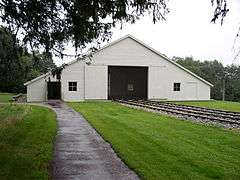 Exterior of Engine House 6 Exhibit Building
Exterior of Engine House 6 Exhibit Building Interior of Engine House 6 Exhibit Building
Interior of Engine House 6 Exhibit Building- Incline looking from the Engine house
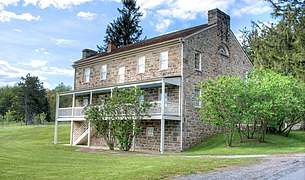 Exterior of the Lemon House
Exterior of the Lemon House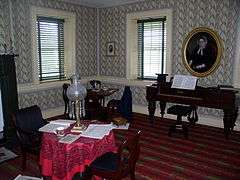 Inside the Lemon House
Inside the Lemon House Inside the Lemon House
Inside the Lemon House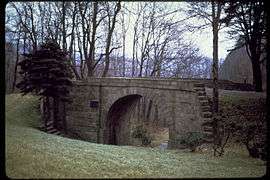 North face of the Skew Arch Bridge at the National Historic Site
North face of the Skew Arch Bridge at the National Historic Site- South face of the Skew Arch Bridge
 Lilly Culvert, built 1832, along the APRR
Lilly Culvert, built 1832, along the APRR
See also
References
- ↑ "NPS Annual Recreation Visits Report". National Park Service.
- ↑ National Park Service (2006-03-15). "National Register Information System". National Register of Historic Places. National Park Service.
- ↑ "Allegheny Portage Railroad of the Pennsylvania Canal". National Historic Landmark summary listing. National Park Service. Archived from the original on October 7, 2012. Retrieved 2008-07-01.
- ↑ "PHMC Historical Markers". Historical Marker Database. Pennsylvania Historical & Museum Commission. Retrieved December 10, 2013.
- ↑ Modern History of Wire Rope by Donald Sayenga
- ↑ Ten inclined planes on the Allegheny Portage Railroad, National Park Service
- ↑ Boucher, John N. History of Westmoreland County, Pennsylvania. New York: The Lewis Publishing Company, 1906.
- ↑ Dickens, Charles (2007) [Written 1842]. American notes for general circulation. Barnes & Noble Books. ISBN 978-0-7607-6892-1.
- ↑ Allegheny Portage Railroad, Gallitzin, PA: Life on the Portage
- ↑ Lindeman, Teresa F. Allegheny Portage Railroad National Historic Site: An engineering marvel, Pittsburgh Post-Gazette, April 19, 2016.
- 1 2 "Basic Information". Allegheny Portage Railroad National Historic Site, Pennsylvania. National Park Service. 10 December 2016. Retrieved 7 November 2017.
- ↑ 107th Congress (4 September 2002), H. R. 4682 [Report No. 107–634]: To revise the boundary of the Allegheny Portage Railroad National Historic Site, and for other purposes (the "Allegheny Portage Railroad National Historic Site Boundary Revision Act") (PDF), U.S. Government Publishing Office, retrieved 21 October 2009
- 1 2 "Things to Do". Allegheny Portage Railroad National Historic Site, Pennsylvania. National Park Service. 31 October 2017. Retrieved 7 November 2017.
- 1 2 Allegheny Portage Railroad: Skew Arch Bridge (PDF), National Park Service, August 2010, retrieved 7 November 2017
- ↑ "Staple Bend Tunnel". Allegheny Portage Railroad National Historic Site, Pennsylvania. National Park Service. 10 December 2016. Retrieved 7 November 2017.
Bibliography
- Baumgardner, Mahlon J.; Hoenstine, Floyd G. (1952). The Allegheny Old Portage Railroad 1834-1854: Building Operation and travel between Hollidaysburg and Johnstown Pennsylvania. Cresson, Pennsylvania: Self Published by the Blair County Chapter and Cambria County Chapter of the Sons of the American Revolution.
- McKee, Harley J. (1980). Introduction to Early American Masonry: Stone, Brick, Mortar, and Plaster. The Preservation Press. ISBN 978-0891330066.
External links
| Wikimedia Commons has media related to Allegheny Portage Railroad. |
- Historic American Buildings Survey (HABS) No. PA-1232, "Skew Arch Bridge, Spanning Incline No. 6", 3 photos, 5 measured drawings, 1 photo caption page
- HABS No. PA-1233, "Staple Bend Tunnel", 2 photos, 2 measured drawings, 1 photo caption page
- Historic American Engineering Record (HAER) No. PA-239, "Skew Arch Bridge, Spanning Incline No. 6", 3 photos, 3 data pages, 1 photo caption page
- HAER No. PA-240, "Staple Bend Tunnel", 2 photos, 3 data pages, 1 photo caption page
- HAER No. PA-483, "Bens Creek Culvert", 5 photos, 1 color transparency, 11 data pages, 1 photo caption page
- National Park Service: Allegheny Portage Railroad National Historic Site
- Allegheny Portage Railroad: Developing Transportation Technology
- Map of the Route
- Allegheny Portage Railroad: Developing Transportation Technology, a National Park Service Teaching with Historic Places (TwHP) lesson plan
- The short film Allegheny Portage Railroad (1993) is available for free download at the Internet Archive
